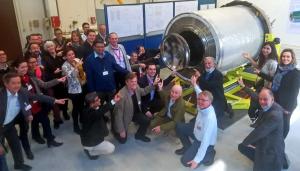Cryopumps
Time to hand over to industry
26 Nov 2018
-
ITER Vacuum Section
After more than 12 years of development, the ITER cryopump is ready for industrial procurement. The Procurement Arrangement for the eight production torus and cryostat cryopumps was signed on 16 November 2018 between the ITER Organization and the European Domestic Agency, Fusion for Energy.
The signature of the Torus and Cryostat Cryopump Procurement Arrangement opens the way to the industrial procurement of the equipment. The European Domestic Agency will procure the pumps and auxiliaries; the ITER Organization will be charged with installation, testing and commissioning. From left to right: Johannes Schwemmer, F4E Director; Robert Pearce, ITER Vacuum Section leader; ITER Director-General Bernard Bigot; and Matthias Dremel, Gilles Wolfers and Roberto Salemme from the ITER vacuum team.
As one of ITER's most complex components, and as a build-to-print procurement package, the Procurement Arrangement contains more than 500 drawings and approximately 400 pages of detailed manufacturing specifications.
ITER will rely on six torus cryopumps to maintain ultra-high vacuum inside the ITER vacuum vessel during operation and to create low density—about one million times lower than the density of air. Two cryostat cryopumps will maintain the low pressure required for the operation of the superconducting magnets.
Following the successful manufacturing of the first pre-production cryopump, a final design review of the equipment took place in March 2018 with experts from the ITER Organization and the European Domestic Agency and external specialists.
According to Robert Pearce, ITER Vacuum Section leader, the design of the ITER cryopumps design has been an engineering challenge due to their operation at both cryogenic temperatures (<4.5 K) and high temperatures (up to 500 K); the precision needed on the moving parts on the world's largest all-metal high vacuum valve; and their core importance to the reliable operation of ITER. "Not only did the pumps have to be designed, but the manufacturing of many of the parts had to be tested. The manufacturing of the pre-production cryopump (delivered to the ITER site in August 2017) paved the way for a successful final design review in March 2018."
This milestone has been achieved due to a strong collaboration between the ITER Organization and the European Domestic Agency, and has involved many actors including European industry and associations.
"Signing this Procurement Arrangement allows the call for tender to be released to manufacture the eight cryopumps," explain the technical officers for the procurement, ITER's Matthias Dremel and Fusion for Energy's Francina Canadell. "ITER will continue its collaboration throughout the manufacturing phase and this shall ensure delivery of the pumps to the ITER site in 2023 for installation in the divertor ports of the vacuum vessel and cryostat. These components are critical to achieving the vacuum necessary to initiate First Plasma in 2025."



